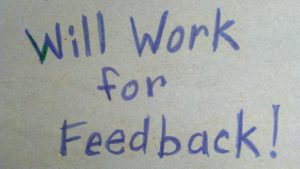Your turn!
A salon for change, challenge, and empowered living.
Building Trust, One Conversation at a Time

“Trust Me”
I suspect that these two words may be the two scariest words in English language. I recall times I’ve heard these words as I was laying in a dentist’s chair or balancing atop an icy crest on a mountaintop as my skiing partner beckons me to follow him down a minefield of moguls.
Perhaps it’s because trusting someone feels like a leap of faith, particularly when you haven’t had the time to cultivate a long-term relationship or you’re feeling unprepared, or fearful.
So is there a way to build trust without years of demonstrating goodwill? Can we cultivate trust with people we’ve only recently met? The answer is “Yes!” but only if you understand the language of trust and how the brain learns to trust.
Sadly, the biggest block to trust is our own brain, which has a built-in negative bias against anything new or different. The brain is constantly on high alert for threats and anything that looks, or feels, scary puts the brain into freeze, fight or flight mode. Through this lens of fear or resistance, it’s difficult to fall into the warm embrace of trust. When it comes to brain function, fear and trust are mutually exclusive.
So how can we move people from fear to trust in a short amount of time? Well you can try to LOOK trustworthy, but that’s risky. Apparently, even clowns can’t be trusted anymore. So we are left with actions, language, or the promise of 100% satisfaction guarantee (which even the most well-intentioned lover has failed to deliver 100% of the time).
Consistent or exceptional behavior or actions are the best way to earn trust. Everyone remembers a trusted vendor by the exceptional actions they took to meet your needs. Another way to earn trust is to deliver on ALL of your promises. A tall order, I know; that is why it’s exceptional, as it distinguishes you from those other folks.
Outside of being exceptional in your actions or deeds, the only other way to earn trust is to speak the language of trust and that is as simple as shifting your language from ME to WE. This trusting business can be scary but it’s easier if we have a buddy. Nobody wants to walk into the haunted house alone. It’s easier if WE walk into the haunted house together.
The language of WE calms the brain and gets it out of fear mode. Imagine a customer is asking for something that you can’t currently provide. One response could be, “that’s impossible, I can’t do that!” Another response could be, “Hmmm, an interesting request. If I was able to find a way to grant that request how might WE both benefit?” When they respond, follow that up with “I like that win/win, how else might WE get to the same outcome?” The brain under threat sees only one path to get what you want, but there are likely many ways to get there. If you partner with someone to explore ALL of those paths to a win-win there is a good chance you will find one that actually does work. Through this conversation, you’re crafting what we Conversational Intelligence® coaches call a “shared success.”
In that shared success, you co-create; the energy shifts and you positively prime your brain for more success in your work together. Your brain puts your client in the category of “ally” instead of “enemy” and is primed to listen and be creative rather than be resistant or distrustful.
We sometimes fail to build trust when we imagine that in order to bring value we must come with the pre-packaged solution. That doesn’t always work, as we lose the opportunity to co-create solutions that better serve our clients and ourselves. Conversational intelligence means knowing when to be quiet and just listen and knowing when to share ideas, share credit, and share success.
Life and business can sometimes feel like a haunted house, or the “Escape Room.” Both of these environments trigger fear, and in fear the brain performs so poorly that we often forget we are in a stage set—a thin, particle-board wall away from freedom. The only way to overcome that fear is to nurture a feeling of safety, adopting the belief that WE will find a way out of this together, which fosters excitement around finding a solution that gets both parties out of harm’s way and closer to shared success.
In this framework, “Trust Me” morphs into “I trust WE will find the solution that benefits both of us.” Not so scary, right?
Laura S. Scott PCC, CPC, ELI-MP is an Executive and Leadership Coach certified in Conversational Intelligence® and the President of 180 Coaching, a Tampa-based Leadership Training and Coaching services provider. Email: Info@180coaching.com or visit www.180coaching.com to find out more.
The Link between Psychological Safety and Team Effectiveness
 Imagine you’re a team member tasked with a highly complex problem and your boss tells your team, “Failure is not an option; we are under close scrutiny from the executive team and we only have one chance to get it right. And if you mess up like we did the last time it’ll be every man and woman for themselves as they show us the door.”
Imagine you’re a team member tasked with a highly complex problem and your boss tells your team, “Failure is not an option; we are under close scrutiny from the executive team and we only have one chance to get it right. And if you mess up like we did the last time it’ll be every man and woman for themselves as they show us the door.”
As you feel the weight of these words settle into your heart and mind, what are you thinking? What are you feeling? Are you excited or are you scared?
One of most intriguing projects to come out of Google in recent years is an initiative called Project Aristotle which set out to use Google data and the experience of Google team members to unlock the secrets of team success and effectiveness.
The assumption going into this project is that if you hired the right people with the right skills and education and experience you could build the perfect team. Right? Wrong.
What the team of statisticians, social scientists, engineers, and researchers found was that education and expertise had very little to do with the success of teams. Instead, what the research team found was that the dependability of the team members was far more important then their skills or education. They also found that a teams’ success depended on the team members having clearly defined goals and roles within the group. Successful teams also understood that their work had meaning and significant impact to the greater good.
Finally, there was one characteristic of enhanced teams that none of the research team members had anticipated, and that was “psychological safety.” Amy C. Edmondson, a Novartis Professor of Leadership and Management at the Harvard Business School has been studying psychological safety for years and she has observed that all that good expertise and talent is wasted if the person doesn’t feel able to speak up and contribute their ideas. In her book titled The Fearless Organization, Edmondson notes that fear is “not an effective motivator” and psychological safety “is not a personality difference but rather a feature of the workplace that leaders can and must help create.”
So how can leaders create psychological safety in their workplace? Here’s some tips, based on my reading of the literature and my experience coaching teams:
- -Welcome and encourage candor and openness.
- -Foster a culture of respect.
- -Find ways to take the fear out of failure.
- -Value the diverse perspectives, skills, talents of each team member.
- -Create a safe space for people to take interpersonal risks without the threat of shame, ridicule, retaliation, or marginalization.
- -Listen from a place of not knowing; challenge your assumptions.
- -Invite each team member to question authority, or the status quo, and positively reinforce that behavior.
The simplest way to create psychological safety is to look for ways to remove the threat or risk of contributing the half-baked idea, or the well-intentioned warning. If neither is welcomed in your organization be clear that you’re effectively putting a muzzle on your most important resource — your people.
So instead of trying to motivate through fear like my example in the opening paragraph, try saying this: “This is a highly complex problem so we are going to need every person in this room to be hyper-focused on exploring all the options, the obstacles, and to muster up the courage to question every assumption we make. I’m counting on each one of you to be thoughtful, respectful, speak up, and to listen to understand.”
Also look for ways to create psychological safety for yourself by understanding your own default threat response; explore ways you can quell your brains’ high alert system before it executes the knee-jerk fear response. One way to do this is to imagine the best-case scenario instead of the worst-case scenario your brain automatically plays out when you are emotionally triggered. If you want to learn how to retrain your brain to do this and learn other brain-based mindfulness techniques for resiliency and emotional self-mastery, please consider joining us at the Pause (II) Power workshop on Nov 9/19 in Tampa Florida
As Amy C. Edmondson said creating psychological safety is not a behavior but it is a practice. It is a practice that is best modeled by leaders who can clearly appreciate the benefits and rewards of making psychological safety a key attribute of their organizational culture, and their own well-being.
The Confidence Gap: Are Women Losing Out Because of the Fear of Taking Risks?
 According to a KPMG report,”less than half (43%) of women said they feel comfortable taking risks.” The biggest reason women don’t take risks–lack of confidence. However, 45% of these same women polled believed “risk-taking helped them gain a whole new set of skills and 33% said it helped them build more respect among their colleagues.”
According to a KPMG report,”less than half (43%) of women said they feel comfortable taking risks.” The biggest reason women don’t take risks–lack of confidence. However, 45% of these same women polled believed “risk-taking helped them gain a whole new set of skills and 33% said it helped them build more respect among their colleagues.”
As a serial entrepreneur, I believe my ability to take confident and calculated risks is vital to my career and financial success, so I was surprised, and dismayed, by these stats. So what can women do to exercise their courage muscles and embrace the risks that allow them to achieve and succeed?
KPMG recommended the following four steps to help female professionals feel more confident:
- Make a conscious effort to ask for what you want, and be clear in those wants
- Stay aware of the impression you make, and be strong in that impression
- Speak up and defend your position
- Take risks—no risks means no rewards
Read more about this report at Techrepublic.com
Read more about how the confidence gaps hurts women in the workplace by clicking here.
What Is Resiliency?

When I began to offer Pause II Power workshops for resiliency and self-mastery, I noticed that most people had a very narrow definition of resiliency. To them resiliency was the “ability to bounce back” after a challenge or setback. To me resiliency means that, and much more. It means self regulation in the presence of a threat or uncertainty. Resiliency requires more than just courage, it requires an infrastructure; a positive, growth mindset, and an ability to find equanimity—that feeling of calm in the midst of chaos—allowing us to quell the brain’s automatic, reflexive threat response.
The human brain has a negative bias, a tendency to err on the side of fear, a tendency to turn the unknown into the “worst case scenario.” If we let our brain fly on automatic pilot, it makes it difficult for us to turn lemons into lemonade. Yet, resiliency is more than just putting a positive spin on a situation, and adding sugar to a bitter brew; it’s a practice that begins with a high level of awareness around our triggers and hot buttons and the stories we tell ourselves in the grip of fear or uncertainty. Most of all it’s about creating a safe space in which to be curious and open to solutions and responses that are out of reach when we are in the grip of the threat response. I invite leaders I coach to find ways to make their team “feel safe on your roller coaster.” Otherwise, you won’t get the best out of them.
A good real life example of this kind of leadership can be found in the NetFlix documentary series titled “The Horn” about the incredibly brave and resilient men and women who staff Air Zermatt, a helicopter service that rescues injured extreme athletes and climbers from the icy peaks and glaciers of Switzerland’s famed Matterhorn, and the surrounding mountains and glaciers. CEO Gerold and his team are called on to execute the most challenging rescues and save lives every day. Rapelling down 100 meters into a glacier crevasse is not for the feint of heart, particularly when the person you are “rescuing” took his last breath well before you arrived.
After a few episodes, I realized that bravery was only a small part of the mix of what makes these pilots and rescuers so resilient. Also present were people who really respected the specialized talents of the other, consistently honored the team’s shared values of life, achievement, challenge, and had total trust in their fellow pilots, rescuers, doctors, and the crack team of mechanics and medics who insured that the helicopters were in top condition and loaded with the supplies to face any situation with extreme confidence. Safety was honored and assured. Everyone in the Air Zermatt team was quick to credit their success to the culture that had been fostered there; a culture that supported emotional self-regulation, trust, camaraderie, healthy living, safety, and a sense of being a part of something much bigger than themselves as individuals. It was clear that all the staff members were proud to be part of the team and hyper aware of their individual contribution to the shared success of Air Zermatt.
The Air Zermatt team showed me how important trust, mutual respect, shared values, and safety is to building high performing teams. What was noteworthy was what I didn’t see as I watched this show: ridicule, blame, or unreasonable demands or expectations. No one asked anyone to do what they wouldn’t be willing to do themselves. And when things didn’t go as planned, no one pointed a finger.
How do you ask for the help you need (even though your brain resists!)?
 Why is it sooo hard to ask for help?
Why is it sooo hard to ask for help?
While there are many reasons why you might resist asking for help, such as ego, fear, rejection, relinquishing of control, it’s impossible to succeed if you don’t ask for assistance. Success is not created in a vacuum and no one achieves anything amazing without the help of others. You might be alone in a lab finding a cure for cancer but you still owe it to the researchers before you who tried and failed (not to mention the poor lab rats) who had a hand in informing your research.
Neuroscientists have noted that the brain likes to be right. Heidi Grant, writing for HBR, reports that: “the social threats involved [when asking for help] activate the same brain regions that physical pain does. And in the workplace, where we’re typically keen to demonstrate as much expertise, competence, and confidence as possible, it can feel particularly uncomfortable to make such requests.”
In her HBR blog post, How to get the Help you Need, Grant identified 3 reinforcements, or benefits, for those who agree to help:
–Effectiveness: People want to see or know the impact of the aid they will give. This isn’t an ego thing. Many psychologists believe that feeling effective—knowing that your actions created the results you intended—is the fundamental human motivation; it’s what truly engages people and gives their lives meaning.
–In-Group: Assure your helper that you’re on his or her team and that the team is important. This taps into the innate human need to belong to—and ensure the well-being of—supportive social circles. Align around a common goal, enemy, or trait, if appropriate.
–Positive Identity: Show how they are uniquely placed (by virtue of their attributes or role) to provide assistance and that they are not merely people who might help you but helpful people who routinely come to others’ aid.
It’s been my observation as a coach that creating the opportunities for shared success around shared values is how we build strong teams. Asking for help, acknowledging the efforts of others, and sharing the credit for the resulting success are the key actions in building trust and ensuring that you will have the support you need to meet your goals and feel a part of something bigger than yourself.
Questions to ask before you ASS-U-ME
You know the old saying: “When you assume something, you make an Ass out of U and Me.” What is it about assumptions that make them so asinin e? Well, mostly it’s because assumptions are rarely 100% accurate and that yawning gap between your assumption and the actual truth is sometimes, well, embarASSing.
e? Well, mostly it’s because assumptions are rarely 100% accurate and that yawning gap between your assumption and the actual truth is sometimes, well, embarASSing.
Blame it on our brains. To shorten our response time during times of threat, our brains became hard-wired to jump to conclusions based on just a shred of evidence. This so-called “evidence” triggers us to recall past incidents (usually stored and labelled as “Very Bad” by the brain) and we react based on the fear-based assumption that what happened before will happen again. This default response time is so quick that the rational, thinking part of our brain can’t keep up, and the primitive part of our brain executes a response based on an assumption before our thinking brain has a chance to investigate further.
So how do we stop the brain default from making an ass of us?
Simple. Recognize when you feel threatened. Then, ask your brain a question as soon as you feel threatened or anxious. This question will invite the thinking part of your brain to pause and investigate, quelling the immediate knee-jerk threat response. Here’s a few simple questions that will challenge the assumptions your brain wants to make and allow you to truly see what is going on in your present world:
- I feel some anxiety. What’s going on?
- I have just been triggered. How do I want to respond?
- Some part of me feels threatened. How can I turn this threat into an opportunity?
Try this for a week, observe how you feel, and report back by commenting below. If you want to quickly get into the habit of asking these questions, there’s an app for that: My Leadership Coach, available for less than $20 by downloading this session on the MindPT app (free in Goggle Play or iTunes). For additional tips, you can also subscribe to our quarterly newsletter and get a free excerpt of my new book: Pause Power.
If you are assuming this is some gimmick, or some martian mind control trick, we have some work to do!
The 4 Key Behaviors of the Super Successful CEO
 Not everyone who makes it to Chief Executive Officer has the skills and behaviors to be successful in their role. In fact, a recent article in the Harvard Business Review noted that “from 2000 to 2013, 25% of the Fortune 500 chief executives who left their firms were forced out. One major reason is that there’s a fundamental disconnect between what boards of directors think makes for an ideal CEO and what actually leads to high performance.”
Not everyone who makes it to Chief Executive Officer has the skills and behaviors to be successful in their role. In fact, a recent article in the Harvard Business Review noted that “from 2000 to 2013, 25% of the Fortune 500 chief executives who left their firms were forced out. One major reason is that there’s a fundamental disconnect between what boards of directors think makes for an ideal CEO and what actually leads to high performance.”
When researchers at ghSmart’s CEO Genome Project looked at a database of 2,000 CEO assessments they found that successful CEOs demonstrated four common key behaviors that either got them the top job, or allowed them to exceed expectations:
1. They are decisive — recognizing that a wrong decision is often better than no decision at all.
2. They engage purposefully for impact — they try to understand their stakeholder’s needs and motivations with a focus on delivering results while also creating value. They are mindful of their emotions and facial expressions understanding that emotions are contagious and expressions and body language can be misinterpreted.
3. They proactively adapt to current situations, while focusing on long-term, big picture strategies that put their companies ahead of the curve.
4. They deliver results reliably. They know how to quell investor nervousness by being predictable in their actions and results, and managing expectations.
Some of the key findings that emerged from this study had much to do with values as behaviors. 90 percent of the successful CEOs showed perseverance and resiliency when dealing with setbacks, not perceiving them as failures but as opportunities to learn. Despite the setbacks, the CEOs proved to be reliable not only in their results but in their own personal conduct. 94% of the strong CEO candidates analyzed scored high on being consistent in following through on their commitments and promises, so there may be something to the old saws, “Be true to your word”, and “underpromise and overdeliver.”
Asking for Feedback? Here’s a Menu of Questions for Biz Owners and Execs
 Asking for feedback from trusted sources is likely the most important thing that you can do to narrow the focus of your personal or professional development plan. CEOs report that getting honest feedback is one of the things they miss most as they move up the org chart. It’s true, when you get to a certain level, there are less opportunities to get actionable feedback, particularly if you a small business owner or CEO.
Asking for feedback from trusted sources is likely the most important thing that you can do to narrow the focus of your personal or professional development plan. CEOs report that getting honest feedback is one of the things they miss most as they move up the org chart. It’s true, when you get to a certain level, there are less opportunities to get actionable feedback, particularly if you a small business owner or CEO.
Often I am asked, as an executive coach, to interview my future client’s peers and stakeholders ahead of an executive coaching engagement so that I can provide my client with a 360 summary of the feedback I receive from conducting short, confidential phone interviews. This feedback summary is crafted so these clients don’t read the verbatim feedback of a particular person (to honor confidentiality of the feedback givers), but that fact doesn’t diminish the value to the client, as they consistently tell me that this feedback summary was one of the most helpful tools in their coaching, allowing us to make the most of our coaching time together.
I also share the following “menu” of feedback questions with clients who want to ask for feedback from their co-workers, forum and mastermind peers, friends, or key stakeholders in open feedback sessions or surveys. I invite you to use these questions however you wish. Just remember to thank those who provided you with the feedback, because feedback is the gift that keeps on giving! Here’s my Feedback Question Menu:
· What do you see as my key strength? What has impressed you about me?
· What have you observed about my behavior that seems incongruent with my “talk” or “values”?
· What would be the one thing that I could work on that would make the most difference in my effectiveness as a leader?
· What would be the one thing that I could work on that would make the most difference in my effectiveness as a communicator?
· What would be the one thing that I could work on that would improve my ability to connect and nurture relationships?
· What would be the one thing that I could change that would enhance my appearance or professional or leadership presence?
· On what occasions do I seem afraid, or not confident?
· What is one skill I could develop further that would enhance my success, or the success of my business?
· If you could identify one thing that you think might be a blind spot for me, what would it be?
· Where do you think my focus should be in terms of personal or professional development?
· What is it about me that you sometimes find distracting, or annoying?
When Perfect Isn’t Perfect

As a reformed perfectionist, I understand the appeal of perfection. Whether it’s the aesthetic appeal of a perfectly cut diamond or the yummy perfection of a beautifully decorated wedding cake, we all appreciate perfection on the occasions it shows up in our lives. We marvel because perfection is so rare and often beautiful.
While perfection is something we all appreciate, we get into trouble when we constantly strive for it. Striving for perfection is a surefire way to set yourself, or others, up for failure and disappointment. And, in most cases, perfection is not necessary, or even good.
Imagine coming into every meeting with the perfect solution. How boring would that be? How would that make your coworkers feel? Imagine if you could not leave your house until every hair was in place and your makeup flawless. How many hours of your life would be consumed with grooming? Who would be waiting, impatient and annoyed? Imagine if every report you presented would be thrown into a fire pit (without a digital copy to rework — horrors!) if it had just one typo or mistake. How would you feel as the author of that report? Yet so many of us strive to achieve perfection in everything we do, and feel disappointment when we can’t.
When I work with senior executive women and they say, “I am a bit of a perfectionist” they are often taken aback when I respond, “perfectionism is a block to success.” But it is true. Perfectionism is the enemy of progress, innovation, and productivity. And perfectionism—practiced as a solo sport—disengages others. Perfect people are just plain annoying.
When I was married I would tell my husband that he was “perfect in his imperfectness” and I believed that. In my thirties, I finally learned to believe that about myself and that new belief changed everything. I began to take delight in the beautiful imperfections that showed up in my world every day: my imperfect smile, the misshapen heirloom tomato, the driftwood on the beach, natural pearls, and the overdone cookies I gobbled down before the guests arrived. I found beauty or value in every one of these things. I understood that God made the perfect and the imperfect as a way to give us contrast and I learned that, like the rose blossom, perfection may be very temporary.
This new belief in the perfection of imperfection freed me from striving for the unattainable. My newfound appreciation for imperfection allowed me to be more creative, more collaborative, less rigid, and less stressed. Most importantly it allowed me to be more compassionate with myself and with others. I understood that we if we valued only that which was perfect we would risk devaluing prototypes, research, opinions, art, cuisine, wine, film, dancing, and our childhood teddy bears.
The reality is that if we expect perfection of ourselves, or others, we will live a life of disappointment. If we strive for perfection we will be crippled by the pressure to perform. If we constantly achieve perfection we will appear less human, and less approachable.
When I was vacationing in Turkey and admiring the beautiful handmade rugs, I was told that the weavers would intentionally weave in a “mistake”— an odd-colored piece of yarn or a break in the pattern — because “only Allah is perfect.” I didn’t spot the “mistake” until the rug merchant pointed it out to me. Step back from the rug, soften your gaze, and the intentional flaw disappears. So I challenge you to make imperfection an art form. Be perfect in your imperfectness. Be that beautiful rug.
Empowering Questions for the Coach-Centric Leader
 When I do workshops on Coach-Centric Leadership, we spend a lot of time crafting empowering questions that leaders can use with their teams to empower, engage, and problem solve.
When I do workshops on Coach-Centric Leadership, we spend a lot of time crafting empowering questions that leaders can use with their teams to empower, engage, and problem solve.
The most challenging thing about this is that sometimes the most empowering questions require that you “play dumb.” When I’m doing a 1:1 meeting with the client I will preface these questions by saying, “Permit me to ask a really dumb question…”
The magic of these “dumb” questions is that they challenge all the assumptions that we are making about what is “true” or possible, we challenge the status quo, and we gain valuable information that otherwise we wouldn’t have uncovered using more direct close-ended questions.
All the best empowering questions start with “What” or “How.” Questions that start with the word “Why” often will put people on the defensive and a person in defensive mode will typically retaliate, clam up, or start to finger point. None of which is good.
I invite you to think about how you can craft four or five open-ended questions starting with “What” or “How” you can have at the ready for those times when you really want to investigate the truth and co-create solutions with your team.
Here’s an example of three empowering questions that I like to use :
“What would be one baby step that you could make this week that would make you feel proud and accomplished and put you closer towards that goal?”
“What are the unknowables that are getting in the way of us moving forward?”
“How might we craft a solution where everybody wins?”
As a coach who has worked with many of the top leaders in a variety of industries, I likely have an answer to all of these questions, but they are flawed, because they are my answers and not my clients.
It’s my job as a coach to empower my clients to craft their own solutions based on their skills, knowledge, and values. The only way I can do that is to shut up and ask the empowering question. And in doing so I learn so much more about my client and what is possible for them and their organizations. The same holds true for the leader. If we can set aside what we know and be curious, we can challenge all of the assumptions, we can exploit the wisdom in the room, and engage and empower others as solution partners.